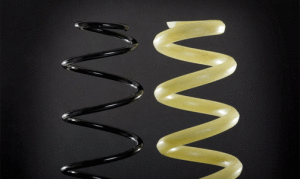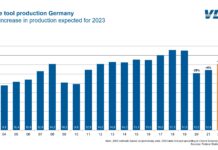 German automobile manufacturer Audi is going to lighten its cars introducing fiberglass springs before the end of the year. The core of the spring is made up of fiberglass strands (GFRP), impregnated with epoxy resin and twisted together. Audi then uses a machine to wrap additional strands of fiberglass around the core and cures the unit in an oven. The strands are wrapped across each other at a 45-degree angle, to allow the load to be equally distributed across the whole spring.
German automobile manufacturer Audi is going to lighten its cars introducing fiberglass springs before the end of the year. The core of the spring is made up of fiberglass strands (GFRP), impregnated with epoxy resin and twisted together. Audi then uses a machine to wrap additional strands of fiberglass around the core and cures the unit in an oven. The strands are wrapped across each other at a 45-degree angle, to allow the load to be equally distributed across the whole spring.
So what benefits do the fiberglass springs hold over steel? To start with, they don’t corrode, even after damage by stone chips, and they’re not impacted by wheel washing chemicals. In areas with snowy, salted roads, there are huge potential benefits to ditching steel for fiberglass. Another key advantage over traditional steel springs is weight. In an upper mid-size car, Audi claims each individual spring weighs almost 2.7 kg (6 lbs), whereas its GFRP units weigh just 1.6 kg (3.5 lb). This adds up to a saving of around 40 percent. While a saving of 4.4 kg (9.8 lb) may seem insignificant, every gram saved contributes to lower emissions and a better driving experience.
Speaking of driving experience, Audi also claims the GFRP springs can be “precisely tuned” for the task at hand, be that ride comfort or a sporty feel, which allows the benefits to be felt across its whole range of cars. To top the whole package off, and in keeping with the low-emissions benefit of weight saving, the GFRP springs take less energy to produce than traditional units.



